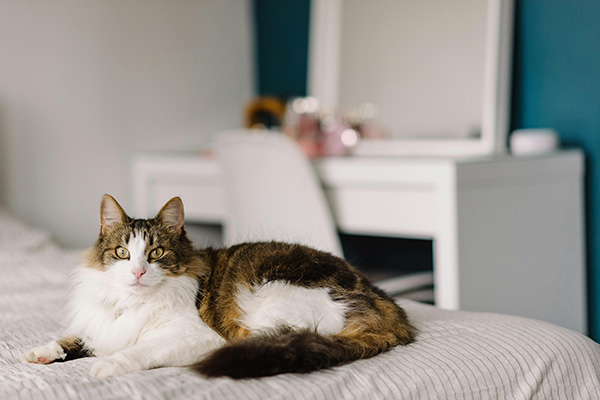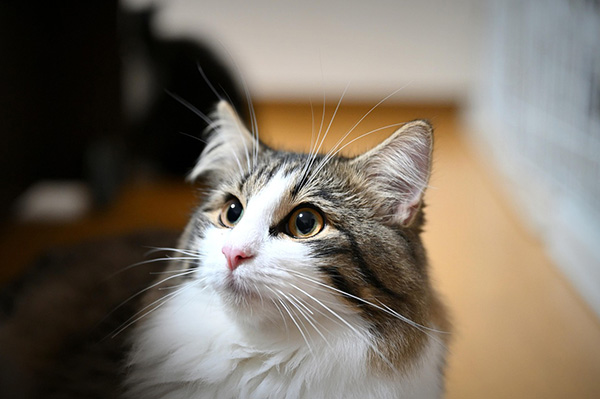If you’re looking for a cat that seems straight out of a storybook, the Norwegian Forest Cat could be the one to enchant you. Known for its luxurious coat, powerful build, and striking almond-shaped eyes, this majestic breed has a history as rich as its appearance. Affectionately nicknamed “Wegies” by fans, these cats are cherished for more than just their striking appearance; they’re also known for being loving and playful companions.
In this guide, we'll dive into everything you need to know about the Norwegian Forest Cat — from its fascinating origins in Nordic folklore to its grooming needs, personality traits, health considerations, and what it's really like to live with one. Whether you're thinking of adopting a Wegie or simply want to learn more about this breed, you'll find all the essential tips and insights you need to become a true Norwegian Forest Cat expert.
Origin
The Norwegian Forest Cat, often called the “Wegie,” has a rich and mythical origin rooted in the forests of Norway. Believed to have existed for centuries, these cats were natural hunters, thriving in the harsh Scandinavian climate thanks to their thick, water-resistant coats and powerful builds. In the 1950s, King Olav V recognized the breed as Norway’s official cat.
Some legends even tie them to Viking ships, where they were used to help control rodent populations. Although they lived as semi-wild cats for generations, efforts to preserve the breed formally began in the early 20th century.
After facing near extinction during World War II, breeders in Norway launched serious efforts to save the breed. The Norwegian Forest Cat breed gained official recognition by the Fédération Internationale Féline (FIFe) in 1977, followed by acknowledgment from both the International Cat Association (TICA) and the Cat Fanciers’ Association (CFA) in the United States. Enthusiasts can connect through groups like the Norwegian Forest Cat Club (NFCC), which promotes breed standards, education, and responsible ownership. Today, the Norwegian Forest Cat remains one of the most popular breeds in Norway, France, and Sweden, and is celebrated worldwide for its beauty, history, and charming personality.
Appearance and Size

The Norwegian Forest Cat size is quite large, and it is a sturdy breed known for its impressive size. Similarly to Maine Coon, Siberian Forest Cat and Ragdoll. Male Norwegian Forest Cats usually weigh between 13 and 20 pounds, while females are smaller, ranging from 8 to 15 pounds. Their long, muscular build is ideally suited for climbing and stamina. This breed also has a strong bone structure and a thick, bushy tail that adds to their overall substantial appearance. Full maturity can take up to five years, allowing them to develop their full size and signature fluffy coat gradually.
Life Expectancy
The Norwegian Forest Cat generally lives between 12 and 16 years. Some may even exceed this lifespan with proper care, a nutritious diet, regular vet visits, and ample physical and mental engagement.
Personality
The Norwegian Forest Cat's personality is sociable, intelligent, easy-going, and curious. These cats are highly observant and love a good challenge, often figuring out how to open doors, cabinets, and other tricky places. Their energy level is moderate; they love to climb, explore, and play, but also appreciate calm lounging time. Although not overly vocal, Norwegian Forest Cats express themselves with soft chirps and gentle meows. They’re social, form strong bonds with their families, and cherish their independence. Confident and self-assured, they adapt well to new environments and are rarely timid. When it comes to affection, they are loving in a quiet, respectful way, often preferring to sit nearby rather than demand constant attention. Their balanced personality makes them a wonderful choice for families looking for an intelligent, active, yet relaxed feline companion.
Temperament
The Norwegian Forest Cat is known for its gentle and friendly nature, making it an excellent fit for families and homes with multiple pets. They usually get along well with other cats and can live peacefully with dog-friendly cats, especially with proper introductions. Norwegian Forest Cats' patient and tolerant nature helps them adapt to new animal companions without much stress.
When it comes to people, Norwegian Forest Cats are typically sociable but not overly demanding. They are polite with strangers, often observing from a distance before approaching. With children, they are especially gentle, showing patience even during energetic play. They tend to prefer environments where interactions are respectful rather than chaotic. Though affectionate with their family, Norwegian Forest Cats value their independence and don't demand constant attention. Their well-rounded nature—loving yet not clingy, social but with a sense of dignity—makes them ideal companions for families, individuals, and seniors. Their adaptable personalities help them thrive in various living environments.
Diet and Nutrition
The Norwegian Forest Cat thrives on a high-protein, meat-based diet that supports its muscular build and active lifestyle. Quality commercial cat foods—whether dry, wet, or a combination—should list real meat as the first ingredient. Due to their larger size, they may require slightly more calories than average cats; however, portion control is essential to prevent obesity. A protein-rich diet, healthy fats, and controlled carbohydrates support a shiny coat, sustained energy, and overall health. Freshwater should always be accessible. Some owners also supplement with occasional lean meats or vet-approved treats to meet their nutritional needs and keep them satisfied.
Adaptability
The Norwegian Forest Cat is exceptionally adaptable and thrives in various living environments. Whether in a spacious house with room to roam or a cozy apartment, they are content as long as they have opportunities for climbing, exploring, and mental stimulation. Their confident and laid-back nature enables them to handle changes, such as new people, pets, or surroundings, more effectively than many other breeds. They are usually calm travelers who settle into new homes with minimal stress. While they appreciate outdoor access in safe environments, they can live happily indoors if provided with plenty of enrichment and vertical spaces.
Trainability

The Norwegian Forest Cat is an intelligent and curious breed, making them quite trainable compared to many other cats. Norwegian Forest Cats quickly adapt to routines and can learn basic commands, tricks, and even how to walk on a harness with consistent positive reinforcement. Their strong hunting instincts and problem-solving abilities make them highly responsive to interactive toys, puzzle feeders, and clicker training. While they are independent thinkers, they generally enjoy mental stimulation and respond well to training sessions that feel like play. Early socialization and consistent, gentle guidance help bring out their best behavior, making them cooperative companions both at home and in new environments.
Shedding
Norwegian Forest Cats shed moderately to heavily, especially during the spring and fall. Their thick double coat is built to shield them from the harsh Scandinavian winters, and they naturally shed their dense undercoat as the weather warms. You may notice significant amounts of fur around your home and on furniture during shedding seasons. Regular brushing—several times a week during peak shedding—helps manage loose hair, prevent mats, and reduce hairballs. Outside of these heavy shedding periods, Norwegian Forest Cats shed at a lighter, steady rate throughout the year. Investing in a good grooming brush and maintaining a routine will help keep their coat healthy and your home cleaner.
Grooming
The Norwegian Forest Cat boasts a thick, water-resistant double coat that is surprisingly low-maintenance compared to other long-haired breeds. Still, regular grooming is essential to keep their coat healthy and tangle-free with the right cat brush. Brushing once or twice a week is generally sufficient, but more frequent grooming may be needed during the spring and fall shedding seasons to manage the heavier coat loss. Their fur naturally resists matting, but attention should be given to areas prone to knots, like behind the ears and under the legs.
Bathing is rarely necessary unless Norwegian Forest Cats become especially dirty, as their coat naturally remains clean. Regular nail trimming, ear inspections, and dental care should also be included in their grooming routine to ensure overall health. A Norwegian Forest Cat’s luxurious coat remains beautiful and manageable with consistent care, requiring minimal daily effort.
Cost
Norwegian Forest Cats typically cost between $800 and $1,500 when purchased from a reputable breeder, with Norwegian Forest cat kittens being more expensive. Prices can fluctuate based on lineage, the breeder's reputation, location, and whether the cat is intended for show or as a companion. Norwegian Forest Cats from champion bloodlines or those intended for breeding or competition can cost $2,000 or more.
Potential Health Problems

Hypertrophic Cardiomyopathy (HCM)
Hypertrophic cardiomyopathy (HCM) is cats' most prevalent heart condition, including Norwegian Forest Cats. It causes the muscular walls of the heart to thicken, which can lead to poor blood flow and eventual heart failure. Symptoms may not be obvious early on, but as the disease progresses, signs like difficulty breathing, lethargy, and sudden collapse may appear. Regular heart screenings, such as echocardiograms, are recommended, especially as the cat reaches middle age. Early detection and proper medical management can significantly enhance the quality of life.
Glycogen Storage Disease Type IV
Glycogen storage disease type IV is a rare yet serious hereditary condition found in Norwegian Forest Cats. It affects how the body processes glycogen, a form of stored sugar, leading to severe muscle weakness, tremors, and failure to thrive. Symptoms often develop within a few months after birth, and sadly, the disease is typically fatal before the cat reaches one year old. Reputable breeders screen for this condition to prevent it, so always confirm that health testing has been done when choosing a kitten.
Hip Dysplasia
Hip dysplasia happens when the hip joint forms incorrectly, leading to looseness and eventually arthritis. Although it’s more common in large dog breeds, Norwegian Forest Cats are also at risk due to their larger size. Signs can include limping, reluctance to jump, or stiffness, especially after rest. To reduce discomfort, it's essential to maintain a healthy weight, provide joint supplements, and ensure easy access to resting areas. In more severe situations, surgery may be necessary.
Periodontal Disease
Norwegian Forest Cats can develop periodontal disease without proper dental care, a painful condition involving gum inflammation, infection, and tooth loss. If not addressed, it can result in bacteria entering the bloodstream, potentially harming the heart and kidneys. Regular tooth brushing, dental treats, and professional cleanings are crucial for keeping teeth and gums healthy.
Chronic Kidney Disease (CKD)
Chronic kidney disease (CKD) is a gradual decline in kidney function that tends to occur more frequently as Norwegian Forest Cats get older. Early symptoms may include increased thirst, frequent urination, weight loss, and a lackluster coat. Starting regular blood tests in middle age can help identify CKD early, enabling dietary adjustments and medications to slow its progression and enhance the cat's quality of life.
Obesity
Due to their laid-back and affectionate nature, Norwegian Forest Cats can easily become overweight if their diet is not adequately managed. Obesity can contribute to or exacerbate various health conditions, such as arthritis, heart disease, and diabetes. Feeding measured portions, avoiding excessive treats, using a slow feeder, and encouraging daily play and activity are essential for maintaining a healthy weight.
